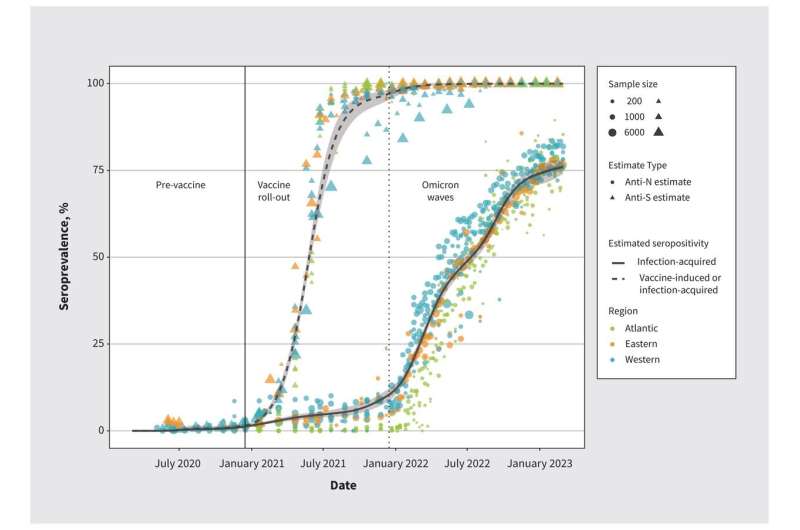Infection
New study charts exposure to SARS-CoV-2 infection in Canada throughout the pandemic
Most people in Canada now have hybrid immunity against SARS-CoV-2 through a mix of infection and vaccination, new research in the Canadian Medical Association Journal shows.
Using pan-Canadian blood sample data from a subset of studies backed by the COVID-19 Immunity Task Force (CITF), researchers from the CITF, in collaboration with those from supported studies, estimated changing levels of seroprevalence—from infection or vaccination, or both—over 3 time periods: prevaccination (March to November 2020), vaccine roll-out (December 2020 to November 2021) and the omicron waves (December 2021 to March 2023).
In the first 2 phases, seroprevalence from infection was low, with less than 0.3% of the Canadian population showing exposure to the virus in July 2020, reaching 9% in November 2021. With the circulation of the omicron variant, infection-acquired seroprevalence rates changed dramatically.
“Despite high vaccine coverage in Canada, all previous increases in seroprevalence due to infection were dwarfed by the increase caused by the omicron variant. After 6 months of the omicron variant circulating in Canada, infection-acquired seroprevalence had risen to 47% by mid-June 2022, with an average monthly increase of 6.4% per month between December 15, 2021, and July 2022.
That seroprevalence ultimately reached over 75% by March 2023,” explains Dr. Bruce Mazer, Associate Scientific Director, Strategy at the CITF, one of the study leads, and Senior Scientist at the Research Institute of the McGill University Health Centre, Montréal, Quebec.
“During omicron, rates of infection-acquired immunity increased faster in younger age groups, with close to 80% seroprevalence in adults under age 25, approximately 75% in ages 25–39 years, 70% in ages 40–59 years, and 60% in those 60 and over by spring 2023,” adds study colead Dr. David Buckeridge, Scientific Lead, Data Management & Analysis at the CITF and Professor, School of Population and Global Health, McGill University.
The low infection rates in Canada before omicron were also evident in other high-income countries in Europe and North America.
“[M]any people in Canada have hybrid immunity against SARS-CoV-2, but variations by age and geography and the potential for waning antibody levels suggest that public health policy and clinical decisions will need to be tailored to local patterns of population immunity,” the authors conclude.
More information:
Matthew B. Stanbrook et al, A new policy on the use of artificial intelligence tools for manuscripts submitted to CMAJ, Canadian Medical Association Journal (2023). DOI: 10.1503/cmaj.230949
Canadian Medical Association Journal
Citation:
New study charts exposure to SARS-CoV-2 infection in Canada throughout the pandemic (2023, August 14)
retrieved 14 August 2023
from https://medicalxpress.com/news/2023-08-exposure-sars-cov-infection-canada-pandemic.html
This document is subject to copyright. Apart from any fair dealing for the purpose of private study or research, no
part may be reproduced without the written permission. The content is provided for information purposes only.

